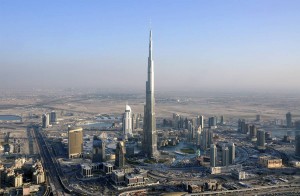By Matt Ridley www.timesonline.co.uk
We are told the world’s newest and tallest skyscraper, the Burj Khalifa in Dubai, will hold 25,000 people at any one time — or three people per square metre of planet that it covers. This makes it, in at least one respect, a good thing. The more intensely human beings use the space they take up, the more space they can hand back to Mother Nature. Intensive farming, cutting the need for more cultivated land, and intensive electricity generation, reducing the need for firewood, have done more to save forests than most policy decisions.

Likewise, cities are good because they pull people out of villages, leaving these to revert to nature.
The notion that city living is green, because it reduces the footprint of human life, has been around for some time among economists. Edward Glaeser, a professor of economics at Harvard, wrote earlier this year: “Living in the country is not the right way to care for the Earth. The best thing that we can do for the planet is build more skyscrapers.”
This month the idea got a surprising new champion: Stewart Brand, the man who all but reinvented the back-to-the-land environmental movement when he founded the Whole Earth Catalog in 1968. It featured all a would-be hippie needed to live the self-sustainable life, from smocks and boots to hoes and seeds, and was itself the seed for a thousand rural communes.
By contrast, Brand’s new book, Whole Earth Discipline, contains a powerful argument that urbanisation is the best thing that could happen. “We’re a city planet,” Brand told the US State Department in a talk last summer. “The aggregate numbers are absolutely overwhelming: 1.3m a week coming to town.” For the first time more than half the world’s population live in urban areas — on just 3% of the land. By the mid-century, 80% of people will be urban dwellers. Brand thinks this is good for both town and country. Nature will reclaim the countryside while cities will brim with creative ingenuity, because proximity is what generates prosperity.
Moreover, he says cities have defused the population bomb. At a time when even Sir David Attenborough is joining the re-trendy alarmism about population, Brand stands out. “Most environmentalists still haven’t got the word. Worldwide, birth rates are in free fall,” he writes. “On every part of every continent and in every culture (even Mormon), birth rates are headed down. They reach replacement level and keep on dropping.”
A country such as Brazil or Italy, with a fertility rate of 1.3 children per woman, will see its population halve in 45 years and halve again in the next 45 years. A big reason is that people are moving to cities where they have fewer children for all sorts of actuarial, financial, educational, feminist, aspirational and spatial reasons.
Brand refuses to join in the worship of rural life: “People are moving to town to escape the poverty trap and ecological disaster of subsistence villages.” He looks at a slum such as Kibera, outside Nairobi, and sees wealth creation rather than poverty creation. “Slums don’t undermine prosperity, they help create it,” he says. “These are not people crushed by poverty, they are busy getting out of it. Put poor people close to rich people and money and services will find their way to the poor, some by theft (such as siphoning free electricity and water from the infrastructure), some by jobs as guards, gardeners, cooks and nannies.”
Brand has a knack of sniffing out the future. In 1966, when everybody was thinking the Apollo programme was about what the moon would look like, Brand was more interested in what Earth would look like from space. He distributed 25 cent badges with the slogan “Why haven’t we seen a photograph of the whole earth yet?” The Whole Earth Catalog followed two years later and the United Nations Earth Day a year after that.
Brand’s status as a seer was further reinforced by his role in assorted other iconic moments of the counterculture: the Trips Festival and the Hackers Conference. By 1985 he was founding what was in effect the forerunner of the website: the Whole Earth ’Lectronic Link, or the Well. There followed the All-Species Inventory and the Long Now Foundation (which calls this year 02010 and has built a monumental clock in a Nevada mountain).
For the same footprint reasons that he champions cities, he believes nuclear power is green, because it takes up far less land than any kind of renewable energy; and that genetically modified food is green, because it promises more intensive use of less land and other environmental benefits.
However, it is his praise of cities that is most original and surprising. This is, after all, the face that launched a thousand communes. “By the late 1960s I had spent enough time on enough rural communes to realise they were intolerable and their rural isolation was a good part of what made them so,” he told me. “The Whole Earth Catalog was a way for me to be useful to the communes without having to live there. By and by almost all of the commune dwellers bounced back to town.”
The most sustainable thing any of us can do is to live in cities, the denser the better. That way we can both prosper and reduce our impact on the planet.
Matt Ridley’s book The Rational Optimist will be published in May Charles Clover is away














